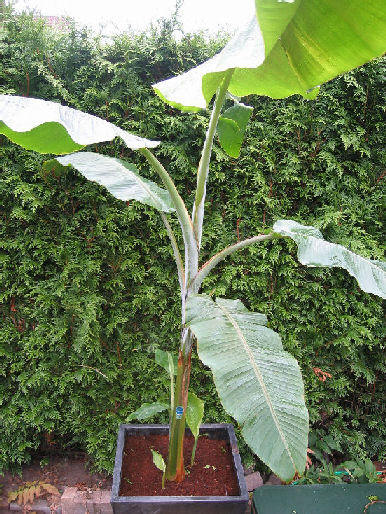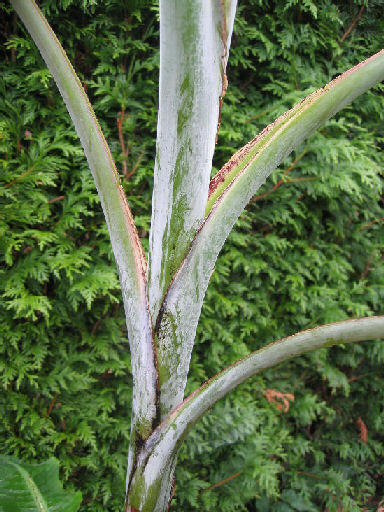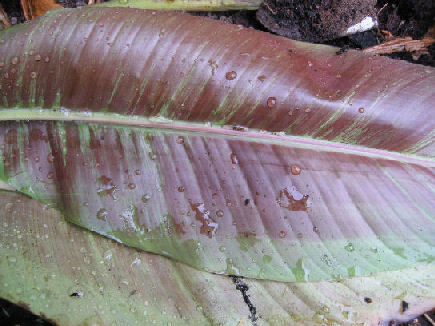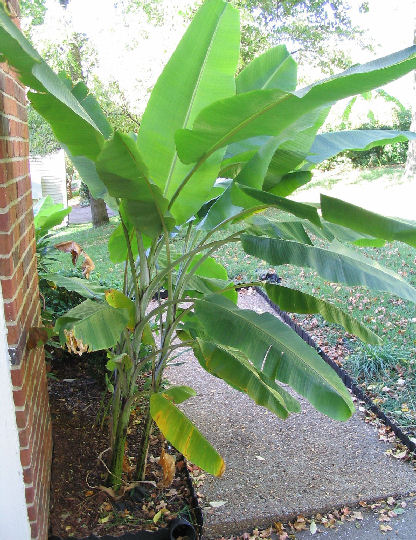

Musa yunnanensis
Yunnan Banana, Wild Forest Banana
One of the in the past years newly discovered banana species in China, probably belonging to the section Eumusa. This is the elegantest of the forest banana species. It grows in the tropical mountain forests in the shadow of the trees and the directly sunlight destroys the leaves, therefore it grows only in the shadow well. One light place must be choosen, anyway in the light shadow like rhododen-drons. The pseudotrunks are white waxed. The species grows to 17 feet and is one oft he species for cold winters and even the leaves are somewhat frost tolerant.
The fruits ripen in the habitat during the summer and are eaten by birds, bats and even elephants. It’s reported that the elephants in the Xishuangbanna National Park love to eat this banana species Totally clearly differences to Musa itinerans are the bluish white waxed pseudotrunk and the at the upper side bluish green leaves with reddish underside.
Unfortunately the previous outplanting trials shown in Germany, that Musa yunnanensis is less hardy than Musa basjoo, I had already made one trial with Musa yunnanensis years ago, which are sold incorrectly as Musa itinerans. Unfortunately it didn’t survive. One wants to have more success, then one should choose mature plants with partly wooded rhizomes and suckers. Also by one by thermostat controlling heated winter protection one outdoor overwintering is possible. Or dig it in the fall up and overwinter it cool and dry at 41°F and replant them in the following spring out.
Recently Markku Hakkinen has described 4 varieties of Musa yunnanensis, they are Musa yunnanensis var. yunnanensis (It seems to be the in the U. S. A. and Europe most cultivated on the description. Pseudostem to 17 feet (5 metres) tall and the inflorescence has 8 hands of fruit.), Musa yunnanensis var. caii (Pseudostem to 13 feet (4 meters) tall and the inflorescence has only 3 hands of fruit)., Musa yunnanensis var. yongpingensis (Pseudostem to 20 feet (6 metres) tall and the inflorescence has 10 hands of fruit.) and Musa yunnanensis var. jingdongensis (Pseudostem to 13 feet (4 meters) tall and the inflorescence has 10 hands of fruit). All of the new varieties are found at high elevations and are frost-tolerant. Musa yunnanensis var. jingdongensis seems to be only know from a few cultivated and Musa var. yongpingensis is known from about 50 cultivated plants, but no wild populations were found in Yunnan, but probably it’s native to Burma, since the populations were found near the border of Burma. Musa yunnanensis var. caii is only known from a few wild populations and a bunch of cultivated populations.
The newer U. S. experiences but show, that Musa yunnanensis is as hardy as Musa basjoo and sikkimensis. But it needs more warmth in the spring to regrow from the corm. This might be a reason for the problem in Germany with the survival of the plant. Probably one hybrid between Musa basjoo and yunnanensis will solve this problem.
Our plants were germinated by Helton Josué from Frutas Raras! But also 2 pups from older speciemens were brought by Helton Josué to me on 16th September 2009, so that I was surprised, the both pups were labeled as Musa 'China', after my inquiry on the web page of Frutas Raras I found, that Helton Josué has already grown this species since longer time successfully in Brazil. I planted them immediately out and will try to cross it with Musa basjoo 'Sakhalin'.
 |
 |
| Musa yunnanensis in the pot (Photo: Wouter Meenhuis, Netherlands) | Close-up view of the bluish white pseudotrunk of one young Musa yunnanensis (Photo: Wouter Meenhuis, Netherlands) |

Close-up view of the leaf underside of Musa yunnanensis (Photo: Wouter Meenhuis,
Netherlands)

One some larger outplanted specimen of Musa yunnanensis (Photo:
Frank Glavin, U. S. A.)
Updated by Joachim Jaeck on April, 3rd, 2010